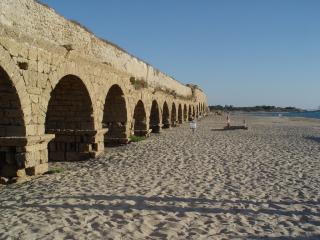Thirty-six miles north of Tel Aviv is one of the loveliest and richest towns in Israel.
Because of its beauty, proximity to the Mediterranean, broad beaches, its wealth of Roman structures, year-round sunny weather, and the presence of the Dan Caesarea, one of Israel’s top luxury resort hotels, Caesarea is a must to visit on any trip to Israel.
And if you’re a golfer, Caesarea also has the only international championship golf course in Israel.
Caesarea was first built between 22 and 10 BCE by Herod the Great as a luxurious port city in honor of Roman emperor Augustus Caesar. Remnants of the ancient city, and its subsequent inhabitants, still stand by the sea in Caesarea National Park, about a half-mile from the Dan Hotel.
Caesarea flourished under the Roman and Byzantine empires, and was occupied by a multitude of different peoples. During the Muslim conquest of the seventh century, it was almost destroyed.
The Christian Crusaders of Europe fought over it with area Muslims, and the fortified walls that stand today were built by a French king, Louis IX, in the 13th century. The Crusader arch, originally an entrance to the city, is still its entrance.
In the archeological remains, you can see remnants of the structures of the various people who lived there. The best way to understand the layers of Caesarea’s history is to see the Time Trek Display that starts with an excellent video.
There are restaurants and cafes in the old city, as well as interesting shops and art galleries. Roman glass jewelry is sold here.
Tickets for seniors are half price.
The Romans were great engineers and built a series of aqueducts to provide water to the city. A standing tribute to their engineering genius, and one of the most extensive aqueducts anywhere, is on the beach in Caesarea, within easy and pleasant walking distance from the Dan Hotel.
Whether you walk to the aqueducts or drive there, your first sight of the strong and massive structure, stretching into the distance, is breathtaking. The aqueducts were designed to drop incrementally from the water’s source to allow the water to do so as well. There are no gates or entrances to the aqueduct, so if there were no other people in sight you might even imagine yourself back in time.
Near the aqueduct is a large well-preserved floor mosaic depicting animals and birds. It was part of a one-acre sixth century mansion, well worth visiting.
The Romans also left a theater that is still used for musical and dramatic performances.
Caesarea is easy to drive in. The roads are wide and smoothly paved.
It’s also a fantastic city for walking. The bushes have flowers on them year round, and much of the area near the Dan, the Old City, and the aqueducts, is open and country-like. Stroll along the beach next to the aqueducts, then watch the stunning Mediterranean sunset as the sun slowly and majestically disappears from the horizon.
The Dan, which was awarded a certificate of excellence by TripAdvisor, has 15 acres for strolling around as well. It has one of the largest and deepest pools in Israel.
The hotel offers free bicycle rentals and the area is great for biking. There are both walking and bike paths to the Old City. Mini golf is another free activity.
For more advanced golf, go next door to the Caesarea Golf Club which offers lessons to new golfers, with special rates for guests of the Dan. Golfers can tee-off next to a Roman pillar.
During the winter season the hotel offers tours of the Old City on Saturdays.
The Dan has floor to ceiling window walls in its rooms and large private balconies to enjoy the warm weather. At night the lights of the harbor and city sparkle.
Along with the old city and aqueducts to tour, Caesarea has interesting museums. They include The Maleor Gallery; the Shuni Archeological Museum with the story of Roman times; the Aaronson Family Home, depicting the first Jewish underground; The Caesarea Antiquities Museum at Kibbutz Sdot Yam; The Old Courtyard at Kibbutz Ein Shemer, with pictures of pioneers and the original dining room; The Ralli Art Museum of biblical art and sculptures by Jewish artists, Latin American art, and 23 original sculptures by Salvador Dali.
A poignant museum is the Hannah Senesh House, the home of the heroine who parachuted into Hungary during World War II and was caught and executed by the German Nazis.
Four nature reserves are in the area, including the Taninim Reserve, with its massive Roman Dam. Here water from two streams flowed across an aqueduct to the ancient city of Caesarea.
For the adventurous, the Diving Club in the ancient harbor offers diving tours of the underwater archeological park.
To be pampered after your tourist exertions, visit Caesar’s Spa with its lush garden and eucalyptus trees.
Finally, Caesarea is within easy access of Israel’s vineyards and other attractions.
Arlene Becker Zarmi is a freelance writer whose work has been published in more than 40 publications nationwide. She was also the producer and host of a travel TV show for Viacom, and is a Jewish genre and portrait artist. She lives with her husband, Rabbi Avi Zarmi, in Shorewood. She wrote this article during a recent visit to Israel.


